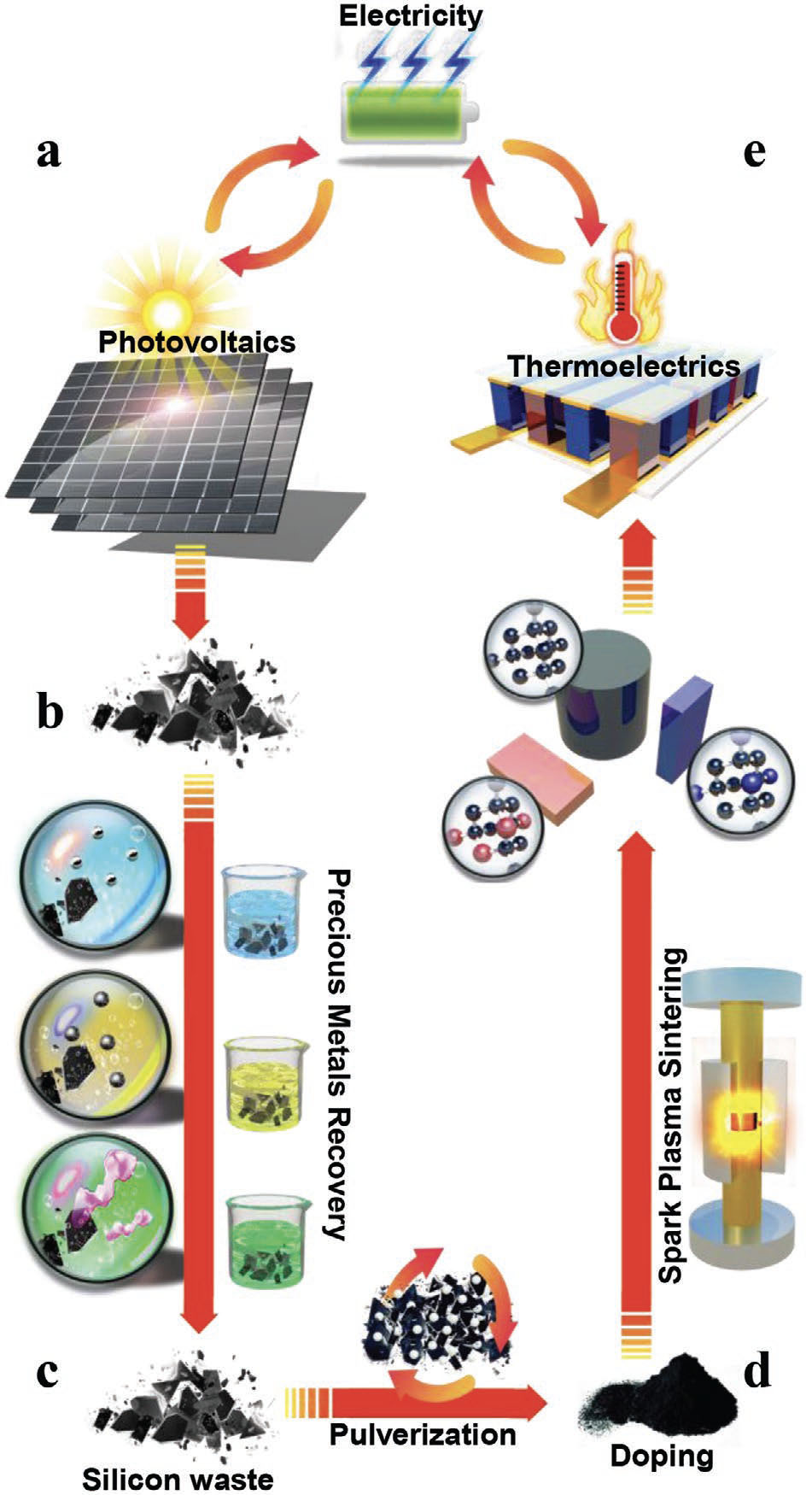| May 16, 2022 | |
Upcycling strategy turns discarded solar cells into thermoelectrics |
|
| (Nanowerk Spotlight) Among the many renewable energy sources, waste heat has enormous potential given the fact that machines and electronic devices emit massive amounts of it. This waste heat could be recaptured by so-called thermoelectric materials, which use temperature differences to generate electrical energy. | |
| Simply put, when one side of a thermoelectric material is hot and the other is cold, an electric charge builds up along the temperature gradient that can be directly harvested as electricity, without moving parts. Depending on the temperature range and device performance, thermoelectrics can therefore either be used as solid-state cooling technology or as heat power harvesting. | |
| In scientific terms, the phenomenon of the thermoelectric effect – the direct conversion of temperature difference to electric voltage – is described by the Seebeck effect and measured by a Seebeck coefficient (volts per difference in temperature). | |
| Just recently, researchers have demonstrated energy harvesting from the radiative cooling of a solar cell at night with the use of a thermoelectric generator – which means the solar cell could generate electricity during the day from sunlight and during the night from the temperature difference between the solar cell and its surroundings. | |
| In this context, an intriguing and novel materials design strategy has now been reported by researchers in Advanced Materials ("Upcycling Silicon Photovoltaic Waste into Thermoelectrics"): They report the upcycling of waste silicon from solar cells into high-performance thermoelectrics. | |
| In terms of materials, 90% of the current photovoltaic (PV) modules are made of crystalline silicon. Although a PV system can produce zero-emission green energy for the 20–30 years of its operation, at the end of its lifetime there is the question of what to do with the discarded solar cells. | |
| Researchers estimate that global PV module waste will reach 1.7-1.8 million tonnes (equivalent to 18 GW) by 2030 and 60–78 million tonnes (equivalent to 630 GW) by 2050, which will likely reach the same order of magnitude as global electronic waste. Until now, most PV modules are discarded and landfilled. As the volume sharply increases, landfill will not be sustainable. | |
| "Our upcycling strategy adds value to otherwise economically low-value waste silicon," Ady Suwardi, an Adjunct Assistant Professor in the Department of Materials Science and Engineering at National University of Singapore, tells Nanowerk. "The most exciting finding of our work is that with proper chemical doping, silicon waste can be turned into high-performance thermoelectrics for heat energy harvesting. This is both timely and significant because thermoelectric generators can actually work in tandem with photovoltaics either to increase their overall efficiency, or to provide power during night time." | |
| The core concept in this study lies in simultaneously facilitating good electricity transport and impeding heat transport via chemical doping and materials processing. Basically, photovoltaics are generally sensitive to impurities and defects whereas thermoelectrics are relatively tolerant to impurities and defects. | |
| "This is due to the majority carrier nature of thermoelectrics, i.e. a degenerate semiconductor," Suwardi explains. "Therefore, by increasing the carrier concentration of silicon photovoltaic waste and introducing phonon scatterers, we achieved high-performance thermoelectrics. Moving forward, we envisage that with proper doping and processing, it is possible to upcycle other semiconductor wastes (beyond silicon) into valuable energy materials." | |
| This upcycled material can then be used for instance for power generation from industrial waste heat or to augment photovoltaics to harvest ambient heat energy. | |
 |
|
| Process flow of turning solar cells into thermoelectrics. a) Commercial solar cells. b) Three-step process of recovering aluminum and silver, leaving behind silicon. c) Silicon pieces were pulverized using ball milling into fine powder in argon atmosphere. d) Doping of phosphorus and germanium were carried out into the fine silicon powder. The mixed powder was thoroughly homogenized before consolidation using spark plasma sintering. e) The final pellets were cut and characterized for structural, electrical, and thermal properties. (Reprinted with permission by Wiley-VCH Verlag) | |
| Many recycling and upcycling approaches focus on recovering raw materials and maintaining the purity of these recovered materials. This present work by the team in Singapore is different in the sense that it directly upcycles waste material from one class of technology (photovoltaics) and turns it into a different, albeit related, class of technology (thermoelectrics). | |
| An important question is the scalability of this upcycling approach in order to make it industrially feasible. The team is already working on scaling up their process to see if it is economically viable to upcycle large amount of silicon waste in the shortest time possible. | |
| "I hope this work will spur similar efforts in the area of upcycling, particularly in electronic (semiconductor) upcycling," Suwardi looks to the future. "In my opinion, the key paradigm here is really that one shouldn't be constraint or too focused on recovering raw materials during recycling, but rather see if the technology can be directly (and economically) turned into another type of technology." | |
 By
Michael
Berger
– Michael is author of three books by the Royal Society of Chemistry:
Nano-Society: Pushing the Boundaries of Technology,
Nanotechnology: The Future is Tiny, and
Nanoengineering: The Skills and Tools Making Technology Invisible
Copyright ©
Nanowerk LLC
By
Michael
Berger
– Michael is author of three books by the Royal Society of Chemistry:
Nano-Society: Pushing the Boundaries of Technology,
Nanotechnology: The Future is Tiny, and
Nanoengineering: The Skills and Tools Making Technology Invisible
Copyright ©
Nanowerk LLC
|
|
|
Become a Spotlight guest author! Join our large and growing group of guest contributors. Have you just published a scientific paper or have other exciting developments to share with the nanotechnology community? Here is how to publish on nanowerk.com. |
|
